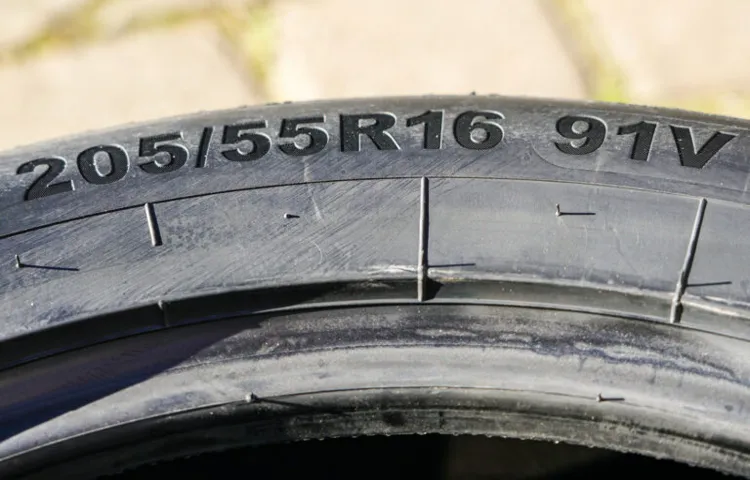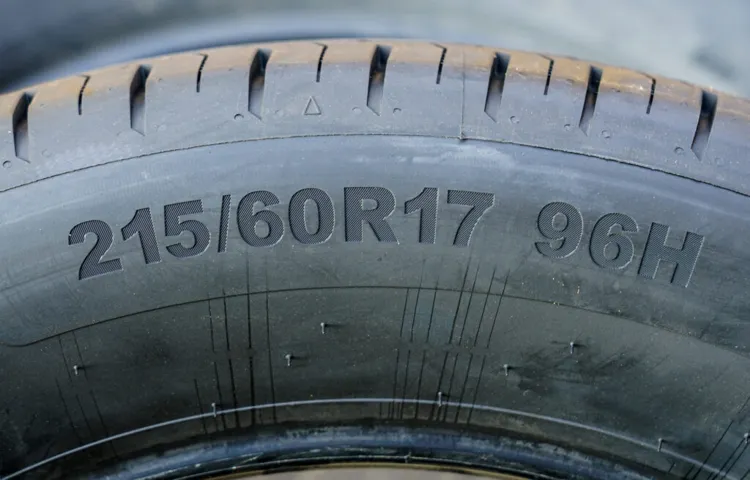Have you ever looked at the sidewall of your vehicle’s tire and noticed a series of numbers and letters? These codes may seem like a foreign language to many drivers, but they hold significant information about the tire’s specifications. One of the most important numbers to pay attention to is the tire rating, which indicates the tire’s maximum load capacity. In this blog, we will be discussing one of the most common tire ratings – the 116T tire rating – and what it means for your vehicle’s performance and safety on the road.
So buckle up and let’s dive into the world of tire ratings!
Table of Contents
Understanding Tire Ratings
If you’re looking to buy new tires and have come across the tire rating 116T, you might be wondering what it means. The number 116 refers to the load index of the tire, which indicates the maximum weight that the tire can support when properly inflated. In this case, 116 means the tire can support 2,755 pounds.
The letter T refers to the speed rating, which indicates the maximum speed that the tire can handle safely. In this case, T means the tire can handle speeds up to 118 mph. It’s important to note that these ratings are only valid when the tire is properly inflated and used under normal driving conditions.
Understanding tire ratings can help you choose the right tires for your vehicle and ensure that you’re driving safely on the road.
Load Index and Speed Rating
When it comes to purchasing new tires for your vehicle, understanding the load index and speed rating is crucial. The load index is a number that indicates the maximum weight capacity that the tire can hold. The higher the load index, the more weight the tire can handle.
On the other hand, the speed rating indicates the maximum speed that the tire can safely handle. The speed rating is represented by a letter, with each letter representing a different speed range. A tire with a higher speed rating can handle higher speeds than a tire with a lower speed rating.
It’s important to select tires that match your vehicle’s requirements to ensure optimal safety and performance.

Decoding 116T Rating
If you’re in the market for new tires or just curious about tire ratings, you may be wondering what exactly 116T means. The 116 on a tire signifies the load index rating, which indicates the maximum weight capacity the tire can handle. In this case, 116 corresponds to a weight capacity of 2,756 pounds per tire, which is quite high and suitable for heavy-duty vehicles like trucks or SUVs.
The T rating, on the other hand, refers to the speed rating or the maximum speed the tire can sustain for an extended period. A T rating means the tire can handle speeds up to 118 mph. So, when purchasing tires, it’s important to consider both the load and speed rating to ensure they are appropriate for your vehicle and driving needs.
116 Load Index (LI)
If you see a tire with a 116 load index (LI) rating, it means the tire is designed to handle a maximum load of 2,755 pounds. The “T” speed rating that often follows the LI rating indicates that this tire is designed to maintain safe operation at speeds up to 118 miles per hour. The rating system is essential because it helps drivers choose the right tire for their vehicle, taking into account the weight the tire is expected to carry.
Tires are not a one-size-fits-all product, and selecting the right one can improve the safety and performance of your vehicle. So, if you’re unsure about what tire to choose, check your vehicle’s manual or consult with a tire professional. Remember that a higher load index rating doesn’t necessarily mean the tire is better; it just means it can handle a higher weight capacity.
So make sure you choose a tire that is appropriate for your vehicle’s weight and your regular driving needs.
T Speed Rating
If you are planning on purchasing tires for your vehicle, you may come across a T speed rating, specifically a 116T rating. This rating indicates the maximum speed that the tire can handle while maintaining proper performance and safety. The T rating refers to a speed range of 118 mph to 130 mph, which is suitable for many vehicles on the road today.
However, the number preceding the letter T, in this case, 116, refers to the maximum load capacity of the tire. So, if you have a heavy vehicle or need to carry a lot of weight, it is important to ensure that the tire can handle the weight before making a purchase. It is essential to understand the different speed and load ratings to ensure that you buy the appropriate tires for your vehicle, providing you with a safe and comfortable drive.
Application of 116T Rated Tires
Are you curious about what a 116T tire rating means and how it can benefit you? Well, a tire rated 116T means it has a maximum load capacity of 1,653 pounds and a top speed of 118 mph. These tires are typically used on light trucks, SUVs, and some commercial vehicles that require robust tires to handle heavy loads and travel at high speeds. The 116T rating ensures that your tires can handle the weight of your vehicle, passengers, and cargo, while also providing excellent traction on the road.
These tires are perfect for those who frequently carry heavy loads or travel long distances at high speeds. Investing in 116T rated tires can enhance your overall driving experience and ensure a safer journey, so consider upgrading your vehicle’s tires today.
Suitable for Heavy-duty Vehicles
When it comes to heavy-duty vehicles, the tires play a crucial role in ensuring the safety and performance of the vehicle. This is where 116T rated tires come in handy. These tires are specifically designed to handle the weight and pressure of heavy-duty vehicles like trucks and buses.
The 116T rating means that these tires have a maximum load capacity of 5,300 kg, making them ideal for transporting goods and passengers over long distances. One of the main advantages of using 116T rated tires is their durability. These tires are made from high-quality materials that can withstand the wear and tear of constant use.
They are also designed to resist punctures and abrasions, which is essential for vehicles that travel on rough or uneven roads. Additionally, these tires have a longer lifespan compared to standard tires, which can help reduce maintenance costs and downtime. Apart from their durability, 116T rated tires also offer better traction and stability.
This is crucial for heavy-duty vehicles that are often carrying heavy loads. With these tires, drivers can enjoy better control and handling, even on wet or slippery roads. This not only improves safety but also helps to reduce fuel consumption and increase efficiency.
In summary, if you operate heavy-duty vehicles like trucks or buses, investing in 116T rated tires is a smart choice. Their durability, traction, and stability make them an excellent choice for long-distance transportation, while their extended lifespan can help you save money in the long run. So, whether you’re a fleet manager or an owner-operator, consider switching to 116T rated tires for your heavy-duty vehicles.
Off-road Use
When it comes to off-road use, having the right set of tires can make all the difference in your driving experience. That’s where the 116T rated tires come in handy. These tires are specifically designed for tough terrains, such as mud, dirt, rocks, and sand.
They provide excellent traction and stability, allowing you to navigate through any trail like a pro. Moreover, their high load capacity enables you to carry heavy loads, making them an ideal choice for camping trips and outdoor adventures. If you are an off-roading enthusiast who loves to explore new paths and challenge your driving skills, then 116T rated tires are the ultimate choice for you.
They provide the necessary support and performance needed to brave through any off-road conditions you may encounter. Overall, using these tires enhances your off-road experience, and you can rest assured that you are driving on the best possible tires for your adventures.
Conclusion
In the world of tires, the ratings can be confusing and overwhelming. But fear not, for the 116t tire rating simply means that the tire has a load capacity of up to 1,984 pounds and can safely travel at speeds up to 118 miles per hour. So, next time you’re shopping for tires, just remember that a 116t rating is no small feat – it’s a tire that can handle some serious speed and weight!”
FAQs
What does the ‘116T’ tire rating mean?
The ‘116T’ tire rating indicates that the tire has a load index of 116 (a maximum weight capacity of 2,755 pounds) and a speed rating of ‘T’ (maximum speed of 118 mph).
What other load index and speed rating combinations are there for tires?
There are many load index and speed rating combinations for tires, ranging from load index 71 and speed rating ‘Q’ (maximum speed of 99 mph) to load index 126 and speed rating ‘Y’ (maximum speed of 186 mph).
How do I know which load index and speed rating are appropriate for my vehicle?
You can find the recommended load index and speed rating for your vehicle in the owner’s manual or on the tire information placard located on the driver’s side doorjamb.
Can I use tires with a higher load index or speed rating than what is recommended for my vehicle?
It is generally not recommended to use tires with a higher load index or speed rating than what is recommended for your vehicle, as this can potentially compromise safety and performance.
Can I use tires with a lower load index or speed rating than what is recommended for my vehicle?
It is generally not recommended to use tires with a lower load index or speed rating than what is recommended for your vehicle, as this can potentially compromise safety and performance.
How often should I replace my tires?
It is recommended to replace tires every 6 years, regardless of mileage, or when the tread depth reaches 2/32 of an inch.
What is the difference between all-season and winter tires?
All-season tires are designed to provide good performance in a variety of weather conditions, while winter tires are specifically designed to perform well in cold and snowy conditions. Winter tires have a different tread pattern and different rubber composition to improve traction and handling in winter weather.


